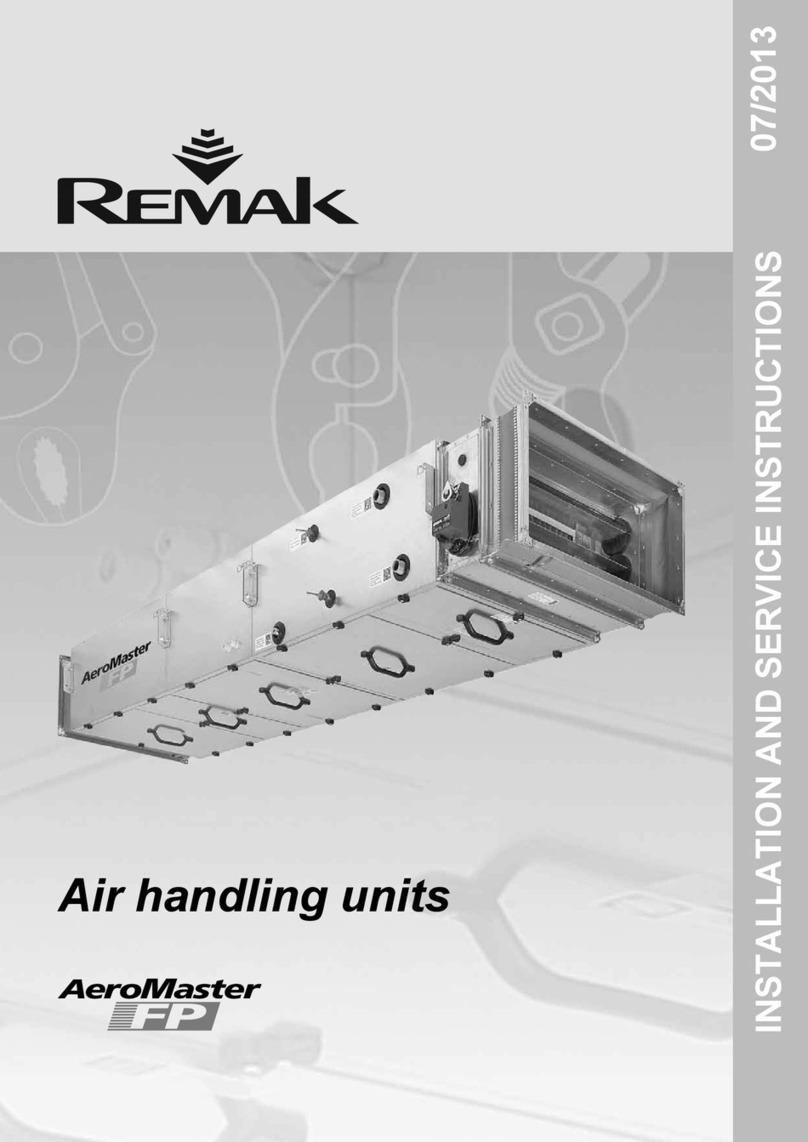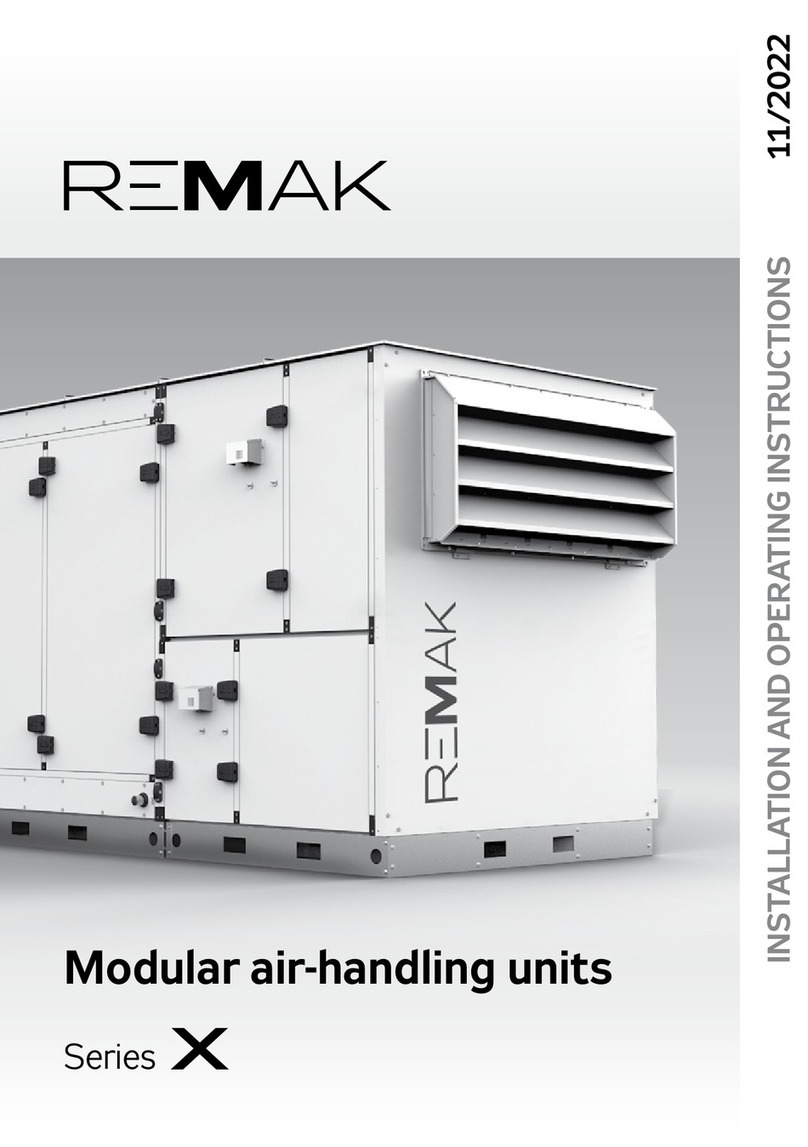
3
Air Handling Units
Application, Operating Conditions and Construction
Manufacturer‘s Notication
AeroMaster air-handling units are manufactured in accor-
dance with valid Czech and European regulations and
technical standards. AeroMaster air-handling units must be
installed and used only in accordance with this documen-
tation. The installation and operating documentation must
be available for the operating and servicing staff, and it is
advisable to store this documentation close to the installed
air-handling unit.
Application and Operating Conditions
AeroMaster Cirrus air-handling units are designed for
comfortableair-handlingandair-conditioninginanairow
range corresponding to the air-handling unit’s cross-sec-
tionandrequiredairowvelocityfrom1.5-4m/satanair
pressure difference of the fan of up to 2500 Pa. The air-
-handling unit is designed as a modular system with a fra-
meandlaminatedconstructionwhichenableshighexibi-
lity.Thusindividualmodicationtocustomerrequirements
is possible. Inner width (W), height (H) and length (L) are
multiples of the module (N × 306 mm) and create space for
the installation of built-in functional assemblies.
AeroMaster Cirrus air-handling units are intended for
installationonoorsorsubstructures,andaredelivered
with a rigid base frame mounted in the factory.
Theyaredesignedtotransportairwithoutsolid,brous,
sticky, aggressive or explosive impurities. The transpor-
ted air must be free of corrosive chemicals or chemicals
aggressive to zinc and steel, respectively aluminium.
They are manufactured with the same construction for
inside as well as outdoor environments, including units
designed for rooms with greater requirements for cleanli-
ness. Air-handling units intended for outside environments
are completed with suitable accessories (roof, louvers,
etc.) ensuring correct and failure-free operation. With the-
se air-handling units, the correct selection, localization and
connection of the M&C components, including anti-freeze
protection, must be ensured.
AeroMaster Cirrus air-handling units can be used in
normalrooms(IEC60364-5-51,resp.ČSN332000-5-
51ed.2,ČSN332000-1ed.2)andinroomswithexten-
ded ambient temperature range from -30 °C to + 40 °C
without additional measures - applies to the standard
version. Custom-made units with decreased -40 °C to
+40 °C or increased -30 °C +50 °C temperature range
of transported air can be delivered.
When designing the air-handling assembly, it is
necessary to take into account the temperature and
humidity of the inlet and outlet air in relation to the
ambient temperature and humidity. It is especially
necessary to analyze the relation of the unit's casing
classicationpursuanttoEN1886andtheriskofcon-
densation, respectively ice build-up.
The device can be used for outdoor installations if
equipped with a protecting roof; the device is water
spray proof (rain up to 60° vertical slant) while obser-
ving the Installation and Operating Instructions.
The fans are equipped with motors insulated with F
class insulation of the winding.
The unit's noise level does not exceed max. allowed
valuesasperStatutoryOrderNo.176/2008Sb,Appen-
dix No. 1, Article 1.7.4.2., Letter u).
Air-Handling Unit Construction
The air-handling unit is designed as a modular system
with a frame and laminated construction. The walls consist
oftwolayersofuniedmodularlaminasattachedtothe
frame.Therstlayeroftheupper,lowerandbackwalls
has longitudinally-oriented laminas while the second la-
yerlaminasarecross-oriented.Thefrontwallttedwith
service panels has laminas oriented in the same direction
in both layers. The service parts (panels) are also of la-
minated construction. Each panel consists of the external
casing with integrated reinforcements.
The panels which are expected to enable occasional servi-
ce access to the internal built-in assemblies are provided
with locks and grab handles to make handling easier. The
panelsusedforregularservicing(replacementoflter
inserts, cleaning of built-in assemblies, etc) are provided
with hinges and locks.
All walls are of sandwich construction with a total insu-
lation thickness of 50 mm. They are provided with a quality
anti-corrosionsurfacenish.Theconnectionsbetween
walls, panels and supporting cross-members are sealed
with a seal with closed cell structure.
The seals used during the assembly of the air-handling
unit’s lamellar walls and casing have a closed cell structu-
re. The non-glued replaceable sealing of the service pa-
nelsisttedintothegrooveontheinnersideofthepanel.
Internal casing: Standard version - galvanized sheet
steel, optionally painted sheet steel (polyester paint) or
stainless sheet steel
External casing: Standard version - galvanized sheet
steel, optionally painted sheet steel (polyester paint) or
stainless sheet steel
Frameproles:Standardversion-hot-dipgalvanized
sheet steel, optionally painted sheet steel (polyester paint)
Insulation of the upper and side panels is made of 50
mm thick non-combustible mineral wool (Class A1 pur-
suantČSNEN13501-1).
Insulation of the lower panels is made of 50 mm thick
PUR foam boards (Class B2 pursuant DIN 4102).
The joints are sealed with silicone compound.
Air-Handling Unit Marking
The complete AeroMaster Cirrus air-handling unit is
divided into "structural" BLOCKS, respectively transport-
installationBLOCKS.Functionally,theblockisdenedby
the internal built-in assembly (assemblies) which is (are)
ttedintotheblock'scasing,wherethecasingiscreated
with laminated walls, supporting cross-members and a
combination of service panels situated on the access side
of the unit.
The air-handling unit is then assembled from the trans-
port-installation blocks at the installation site. At the outlet,
thetransport-installationblocksarettedwithanendpanel
or a frame to be connected to the next block.
BLOCK is provided with a BLOCK type (name) plate
indicating the following data:
Manufacturer's name (incl. logo) and address
Type, size and marking code of the BLOCK
BLOCK serial number
Ordernumber(serialnumber)/yearofproduction
Weight






























